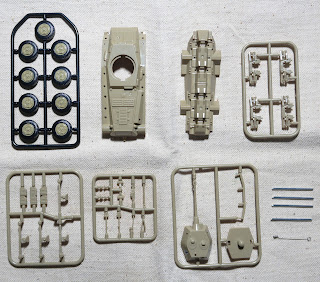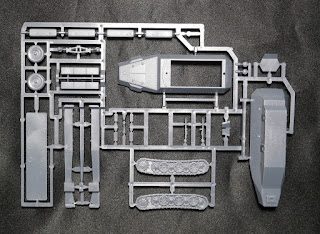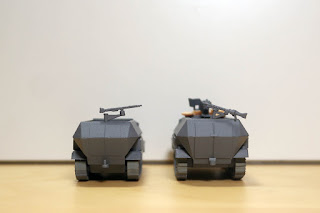The first two kits are WWII German heavy armored cars. They are both referred to as "Cougar" armored cars in the translated text, since the same word is used for both "cougar" and "puma" in Chinese. In any event, I will use the word "puma" for the purposes of this post.
4D Model also seems to be doing OEM for a company called Pambest, who are selling the 4D kits under their Pocket P Museum brand (the marketing material looks to be styled after the Kaiyodo Capsule Q Museum series).
 |
| Pocket P Museum |
 |
| Capsule Q Museum |
The first model is the Sd.Kfz.234/2 Puma Armored Reconnaissance Vehicle (美洲狮裝甲偵察车), consisting of 26 parts in khaki plastic, 9 wheels in black plastic with painted hubs, 4 metal axles, and a wire antenna.
The second model is the Sd.Kfz.234/3 Puma Wheeled Armored Vehicle (美洲狮轮式裝甲车), which we might also call a Stummel 8-rad, consisting of 50 parts in tan plastic, 9 wheels in black plastic with painted hubs, 4 metal axles, and a wire antenna.
The models go together very quickly and easily, but the directions for how the axles fit onto the chassis are the opposite for the two models, and I couldn't figure out which direction was correct at first.
In the end, I think the instructions are both half-right, and there should be a pair of struts pointing forward, and a pair pointing backward.
Immediately there are several obvious issues with the models, including the poorly rendered jerry cans, and lack of tread pattern on the tires.
The barrel of the Puma is warped, and has the vents opened to the top and bottom as opposed to the sides. The smoke launchers are poorly represented, and only have two dischargers on each side.
Meanwhile, the Stummel has markings that are out of register, a poorly formed co-axial machine gun, and big, chunky steering wheels.
The models are strictly wargaming pieces, and are not the best representatives of the 4D Model offerings. They do have the advantage of tools that are provided as separate parts, and the Stummel comes with a rudimentary interior.
It probably wouldn't be too hard to make them into passable display models either, if you really wanted to.
I didn't use the wire antenna on the Puma because the instructions tell you to install part 4B, and then cut it off to leave a post for the metal antenna. If I had looked carefully at the instructions before starting, I would have just used a piece of sprue for the post, and saved the part for something else.
The next two models are modern PLA vehicles consisting of the ZBD-04A Tracked IVF (ZBD-04A 步兵战车步兵战车), and the ZBL-09 Snow Leopard IVF (雪豹 ZBD-09式 步兵战车).
The ZBD-04A consists of 43 parts in tan plastic (a green version of this model also exists), and two wire antennae.
The ZBD-09 consists of 26 parts in green plastic, 8 wheels in black plastic with painted hubs, and 4 metal axles.
Assembly of the models is very simple, but one interesting feature is the way the bustle racks for the ZBD-04 require folding before installation.
This is something you would typically do with photoetch, but the properties of the plastic used for the kit makes it possible to get a similar effect without the need for special tools, or having to complicate the mold.
I painted the tracks and wheels of the ZBD-04 before assembly because the side skirts would make painting difficult after the upper and lower hulls are connected.
The ZBD-04 has a choice of two configurations based on the parts attached to the hull. I went with option 1, but I'll probably order another model to build the other configuration.
Hatches on the hull and turret can open and close, but a bit of clean-up may be needed for the hull hatch to fully close. The barrel can pivot up and down, and the turret can rotate.
The 4D ZBD-09 is very similar to the Dragon Armor ZBL-09, albeit a bit less detailed. Both chain-guns are simplified and fixed in a raised position.
 |
| 4D (left) v Dragon (right) |
For both models, options are provided to have the turret hatches opened or closed. I went with the closed option for the 4D model, and open option for the Dragon model.
 |
| Dragon (top) v 4D (bottom) |
The Dragon model comes with two doors for the rear hatch to allow the model to be displayed with open or closed hatch. The 4D model has a hinged door so the hatch can open and close.
 |
| Dragon (left) v 4D (right) |
The only thing that was obviously inaccurate on the 4D model from what I can tell are the front mirrors.
The mirrors of the Dragon model are the correct rectangular shape, while the 4D model has round mirrors.
Overall, I would say that the models are not too bad, though they would look more like actual PLA vehicles if they were painted with [digital] camouflage. It's also odd that the national markings do not have the "八一 " inside the emblem, which makes them look a bit off.



















































































